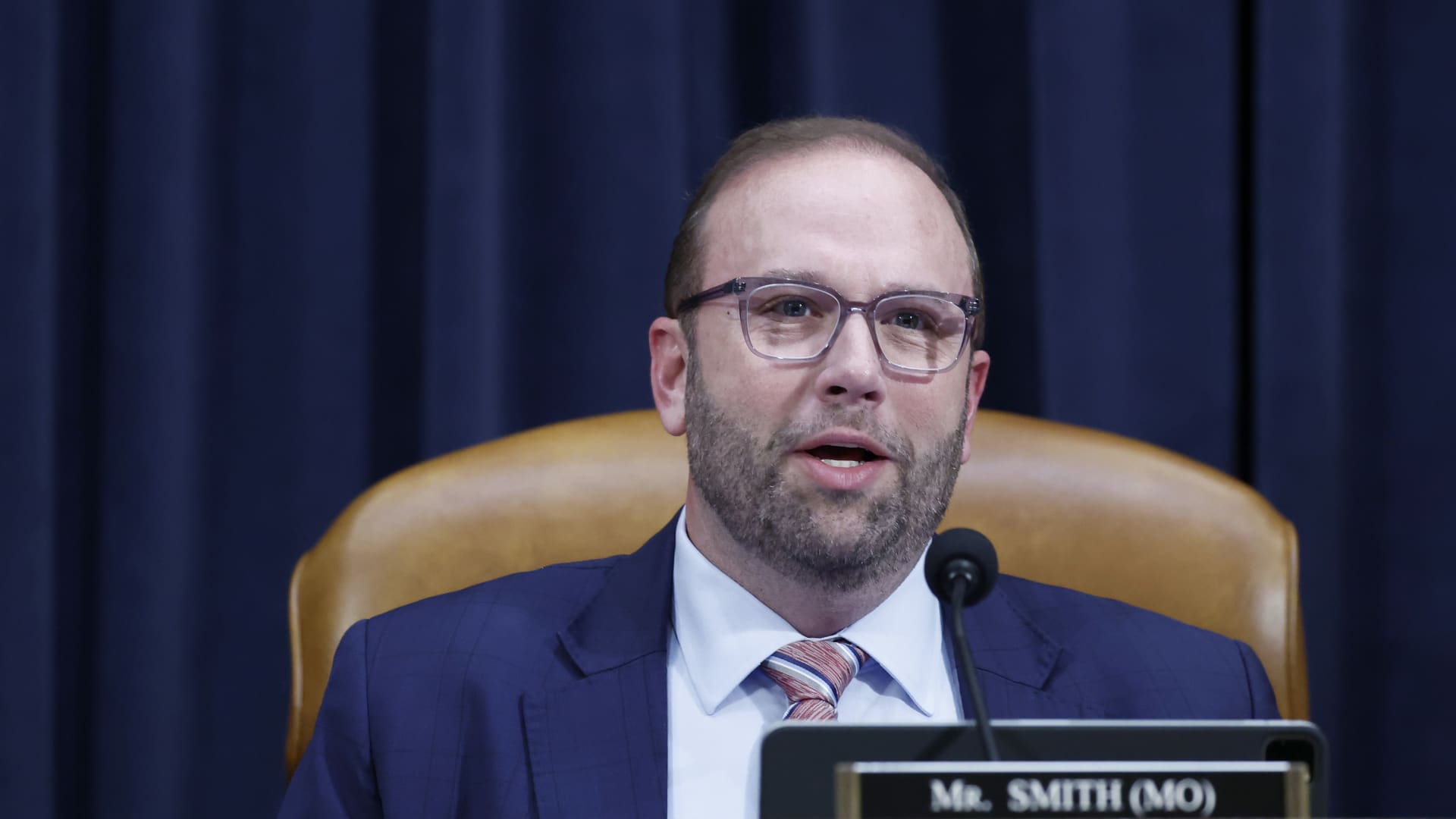Chairman Jason Smith (R-MO) speaks during a House Committee on Ways and Means in the Longworth House Office Building on April 30, 2024 in Washington, D.C.
Anna Moneymaker | Getty Images News | Getty Images
House Republicans on Thursday advanced a multi-trillion-dollar tax and spending package that could have sweeping impacts on household finances.
If enacted, the legislation — called the “One Big Beautiful Bill Act” — could make permanent President Donald Trump‘s 2017 tax cuts, while adding new provisions that could significantly overhaul student borrowing, health savings accounts and car ownership, among other changes.
With control of Congress, Republicans can use “budget reconciliation” to pass the package, which only needs a simple majority in the Senate. But the bill, which is more than 1,000 pages long, is likely to see changes in the upper chamber before Trump signs it into law.
Here are some of the provisions that may affect your wallet.
Higher ‘SALT’ deduction limit
Enacted via the Tax Cuts and Jobs Act, or TCJA, of 2017, there’s currently a $10,000 limit on the deduction for state and local taxes, known as SALT. Filers must itemize deductions to claim it.
The bill would raise the SALT cap to $40,000 in 2025 and phase out the tax break for incomes over $500,000. The SALT limit and income phaseout would increase annually by 1% from 2026 through 2033.
Before TCJA, the SALT deduction was unlimited, but the so-called alternative minimum tax curbed the benefit for some wealthier Americans.
The bill would also reduce itemized deductions for certain taxpayers in the 37% income tax bracket, which could limit the benefit of the higher SALT cap.
“Any changes to lift the cap would primarily benefit higher earners,” Garrett Watson, director of policy analysis at the Tax Foundation, wrote in an analysis on Tuesday.
Bigger child tax credit
Trump’s 2017 tax cuts temporarily boosted the maximum child tax credit to $2,000 from $1,000, an increase that will expire after 2025 without action from Congress.
The House bill would make the $2,000 credit permanent and raise the cap to $2,500 from 2025 through 2028. After 2028, the credit’s highest value would revert to $2,000, and be indexed for inflation.
However, the plan does “nothing for the 17 million children that are left out of the current $2,000 credit,” Kris Cox, director of federal tax policy with the Center on Budget and Policy Priorities’ federal fiscal policy division, previously told CNBC.
The reason for that is that very-low-income families with kids typically don’t owe federal taxes, which means they can’t claim the full child tax credit.
Medicaid, SNAP cuts
To help pay for the tax relief in the bill, House Republicans have included roughly $1 trillion in cuts to Medicaid health coverage and the Supplemental Nutrition Assistance Program, or SNAP, that are the largest in the programs’ histories.
As a result of the changes in the bill, which include stricter work requirements to qualify for the programs, 14 million individuals may lose health coverage, while 3 million households may go without food assistance, according to Accountable.US, a nonpartisan watchdog group.
While Medicaid work requirements had been slated to go into effect in 2029 per earlier versions of the proposal, House lawmakers moved that date up to December 2026 in last-minute negotiations.
‘Bonus’ deduction for older adults
Catherine Delahaye | Digitalvision | Getty Images
Low- to middle-income seniors will be able to deduct an additional $4,000 on their tax returns, based on the terms of the House bill. The full deduction, dubbed a “bonus” in the legislation, would apply to individual tax filers with up to $75,000 in modified adjusted gross income and married couples with up to $150,000.
The tax deduction reduces the amount of seniors’ income subject to taxes, and therefore may also bring down the taxes that they owe.
The deduction is in lieu of the elimination of taxes on Social Security benefits, a proposal touted by Trump on the campaign trail. Changes to Social Security are prohibited in reconciliation legislation.
Health savings account expansions
There are many provisions in the GOP bill tied to HSAs, tax-advantaged accounts used to pay for health care. They carry powerful financial benefits for those with access.
The legislation aims to both expand households’ ability to contribute to HSAs and to use those funds without financial penalty, said William McBride, chief economist at the Tax Foundation. The HSA measures would kick in starting in 2026.
More from Personal Finance:
House Republican tax bill passes ‘SALT’ deduction cap of $40,000
SNAP benefits face ‘biggest cut in the program’s history’ under GOP tax bill
Senate passed a surprise ‘no tax on tips’ bill. What it could mean for workers
One tweak allows households to use HSAs to pay for expenses tied to sports and fitness, like gym memberships or instruction. Eligible expenses are capped at $500 a year for individuals and $1,000 for couples.
The bill also doubles the annual contribution limits for low and middle earners, to $8,600 for individuals and $17,100 for married couples in 2025. (This applies to individuals who make less than $75,000 per year and $150,000 for married couples.)
New ‘Trump Accounts’ for child savings
MoMo Productions | Stone | Getty Images
Trump’s tax package also includes a new savings account for children with a one-time deposit of $1,000 from the federal government.
Funded by the Department of the Treasury, “Trump Accounts” — previously known as “Money Accounts for Growth and Advancement” or “MAGA Accounts” — can later be used for education expenses or credentials, the down payment on a first home or as capital to start a small business.
If the bill passes as drafted, parents will be able to contribute up to $5,000 a year and the balance will be invested in a diversified fund that tracks a U.S.-stock index. Earnings grow tax-deferred, and qualified withdrawals are taxed at the long-term capital-gains rate.
Reduced student loan benefits
The bill would eliminate subsidized federal student loans, meaning that the government would no longer cover the interest on the debt while borrowers are in school or during other key periods. The change could increase a student’s loan balance at graduation by about 15%, said higher education expert Mark Kantrowitz.
While the U.S. Department of Education’s current income-driven repayment plans for student loan borrowers typically conclude in debt forgiveness after 20 or 25 years, the new GOP plan wouldn’t lead to debt cancellation for 30 years in some cases.
“A 30-year repayment term means indentured servitude,” Kantrowitz said.
The legislation would also nix the unemployment deferment and economic hardship deferment, both of which student loan borrowers use to pause their payments during periods of financial difficulty.
Car loan interest deduction
Andresr | E+ | Getty Images
The bill creates a tax deduction for car owners who pay interest on an auto loan, for tax years 2025 through 2028.
The tax break is worth up to $10,000 for annual loan interest on passenger vehicles, such as a car, minivan, van, sport utility vehicle, pickup truck, motorcycle, all-terrain or recreational vehicle. It’s an above-the-line decoration, meaning taxpayers can get it even if they don’t itemize their tax deductions.
There are some restrictions: The deduction’s value starts to decrease when a taxpayer’s modified adjusted gross income exceeds $100,000, or $200,000 for married couples filing a joint tax return. Also, the car must be assembled in the U.S. to qualify for the tax break.
Tax break on tip income
Workers who receive tips could get a tax break under the bill, which exempts qualified tips from income tax through 2028. It’s limited to those who earn less than $160,000 for 2025.
The Senate unanimously passed a similar bill on Tuesday that would limit the tax break to $25,000.
EV, clean energy tax credits
The House bill would mean an early termination of tax breaks for consumers who buy or lease electric vehicles, and others for households that make their homes more energy-efficient.
Many of these credits have been available in some form for decades. The Biden-era Inflation Reduction Act extended or enhanced them.
The House legislation would end the tax breaks after 2025, with few exceptions, about seven years earlier than under current law.
Those on the chopping block include a $7,500 tax credit for new EVs and leases, and a $4,000 credit for used EVs.


 Economics1 week ago
Economics1 week ago
 Personal Finance1 week ago
Personal Finance1 week ago
 Economics1 week ago
Economics1 week ago
 Economics6 days ago
Economics6 days ago
 Personal Finance1 week ago
Personal Finance1 week ago
 Economics1 week ago
Economics1 week ago
 Economics1 week ago
Economics1 week ago
 Economics1 week ago
Economics1 week ago











